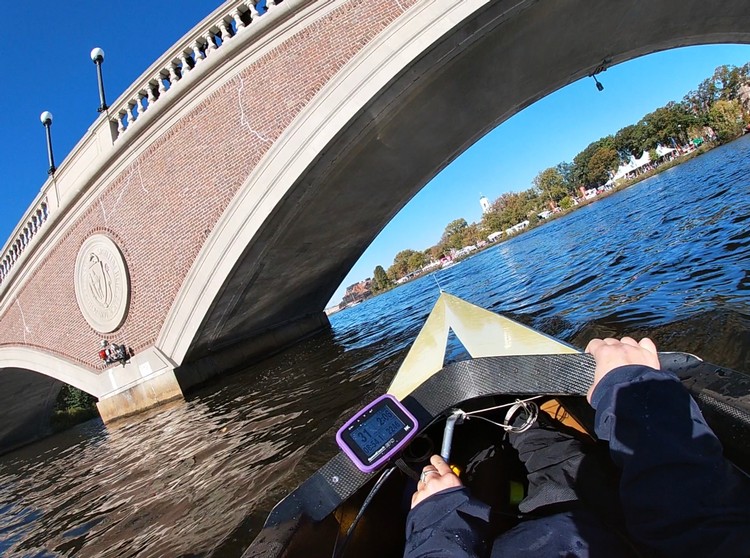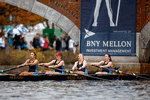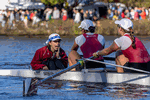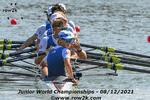In the Driver's Seat, with Mia Saracino

Next up In The Driver's Seat--where we hear from the folks who keep the shells straight and the crews fast--is coxswain Mia Saracino.
Mia has four plus years at the helm in Rhode Island, with both her high school--St. Mary Academy-Bay View--and now with, as she puts it, the "mighty Masters" of the Narragansett Boat Club.
She steered Narragansett's Grand Master Men's Four to sixth at the 2022 Head of the Charles, and judging by this week's cover photo from the driver's seat itself, Mia has figured out the key to taking a good line through Weeks: get really, really close.
Let's hop In The Driver's Seat with Mia:
row2k - What do you see as the three most important things for being a successful coxswain?
Mia Saracino - In my opinion, all successful coxswains are confident, attentive, and responsible.
Being confident, or at least acting like you are confident, will increase the level of trust and respect your crew has for you. Consciously or subconsciously, rowers will notice how you handle certain situations and react accordingly. I struggled a lot with confidence in my novice season after a few bad practices. I had rowed for a season, so I knew which calls to make and when, but I had a very challenging time with picking up the steering.
Something that I have noticed from my own personal experiences or from conversations with other coxswains, is the backlash and ridicule a lot of coxswains face as novices. Just know, especially if you are a novice coxswain, that you DO NOT have to be the perfect varsity coxswain your first season. You will make mistakes, but if you learn from them, and want to improve, you will and you can.

Coxing is all about being attentive to your point, your surroundings, your rowers, and your coaches. At practice and on race day, you must be on top of your steering and thinking about what is in front of you: physically, mentally, and strategically. This applies more to head racing, but you have to anticipate turns and watch for hazards whether they are barges, other crews, buoys, trees, etc. You also have to pay attention to your rowers: what they are thinking, how they are feeling, and the technique they are displaying. Creating a relationship with your rowers, even if it is strictly athletic, is important to gaining trust and camaraderie amongst your crew. On the water, it is imperative that you also know their mental and technical weaknesses.
We know all too well the immense responsibility that is put on coxswains, even at the middle school and high school levels. Coxswains are responsible for the four or eight other athletes in their shell, the equipment, and themselves. On top of the obvious roles and responsibilities of a coxswain, I think one must also be responsible for their actions and self-improvement. Although we are part of the team, I feel as if coxswains have to maintain a level of composure and professionalism around the team. Coxswains are leaders and must set an example for the rest of the team.
Another thing I have noticed from talking with others in the ninth seat is the lack of coxswain education from home teams. Many coaches give the advice to row or listen to recordings, but these things don't help you learn the other parts of the job like steering, weather, boat handling, and other actions necessary for a successful and efficient practice. Two things I have done in the past couple seasons that have improved those aspects of my coxing were using more comprehensive weather websites (like Dark Sky, which shows exact wind direction on a map) and using Strava to track my steering.
row2k - What is your favorite drill to run with your crews? Any tips on how to the drill well, for maximum effectiveness?
Mia Saracino - My favorite drill, which I believe is applicable to crews of all levels, is the reverse pick drill.

It can be done by pairs, fours, sixes, all eight, you name it! Rowers start at the catch, with the top quarter of the leg drive, then progress to half-slide, and full slide before adding the bodies, and lastly, the arms. This drill is incredibly helpful for synchronicity off the front end. Going legs and bodies only helps sync up the body swing, allows the crew to feel the "hang" off the oar handle, and places emphasis on the more powerful parts of the stroke. I swear, every time I run this drill, I feel a HUGE difference. The strokes are more powerful, focused, and there is more acceleration on the drive. As one of my coaches says, you can feel way more "oomph!"
I am a total perfectionist, so I try to make sure I help my crews nail down each part of the drill before progressing to the next. I think it is more important to drill the proper technique, even if it takes a few more strokes, rather sticking to a pre-set number of strokes at each station.
Personally, I like to try to use my voice to emphasize the different parts of the stroke: when we are going top quarter, my calls are quicker and more direct. My goal is to help the rowers lock the blades in cleanly without hesitation. When we add the other parts of the stroke, I try to say what the rower should be doing or feeling at that point in the stroke: "Lock, push, swing" or "Jump, hang." I also think it is more than proper to take a few strokes in complete silence to let the rowers feel and hear what it sounds like to properly complete each part of the stroke. Giving ample transition time seems basic but is important for maintaining synchronicity.
row2k - What's some of the best coaching advice you've received about your coxing?
Mia Saracino - Something that I find very applicable, even more so when coxing masters, is not talking for an entire race just to fill empty time, especially in a head race. Not only do the rowers tend to tune out this "mindless chatter," it also takes some of your focus off steering.
I spend a lot of time in coxed fours which relies heavily on boat feel. When I started implementing more of this structured silence into my coxing, I also became aware of the various sounds of the rowing stroke. Hearing the blades go in the water and the run underneath the hull can focus your calls to increase boat speed. It is 100% ok to take time to listen and feel what is going on in the boat. If effective, your rowers will also gain more confidence in you and your abilities as a coxswain.

row2k - What is a mid-race call or move that you've made that you'll remember for the rest of your life? If so, what did it involve and how did you call it?
Mia Saracino - The best move that I made in the middle of a race was at Newton Country Day School (NCDS). This was my first time racing on the 'pond' on the Charles and I wasn't quite sure what to expect with the curved course.
About half-way through the race, the NCDS boat had open water on us, but I noticed their efficiency had decreased considerably. I told my crew "They're getting sloppy, we're staying clean. In two, we take ten just for us." From there, we started taking seats and I realized what was going to happen. NCDS saw it too and got sloppier and more frantic, but we all trusted our technique and fitness and just went for it. At the end of the race, we won with open water. My crew was ecstatic because we thought we were going to be smoked. Our coaches were really surprised and excited by the outcome of the race as well.
row2k - Can you tell us anything about how you learned how to make motivating calls?
Mia Saracino - Let me preface this by saying each crew will require different calls to motivate them. For the majority of my coxswain career, I have coxed high school girls at St. Mary Academy-Bay View. I recently started coxing masters men, who have much different ideas of race-day motivation.

Regardless of age or ability, one thing I try to do is ask my rowers for feedback on my calls: which ones they like, dislike, and which they want me to incorporate on race day. This method of selection doesn't always work because sometimes rowers are unwilling to share their thoughts to preserve their coxswain's feelings. If you can't get explicit feedback from your rowers, I would try out different calls during practice pieces and see what sticks or makes an impact on boat speed.
Besides the more personalized motivating calls, I think that information is motivation. During a race, you should give your crew how far they are into the race or how many meters they have left, their elapsed time, their stroke rate, and their split (if you have a SpeedCoach). If we are close enough to another boat, I also tell the rowers where they are in relation and call moves accordingly. Personally, I also think it is important to think ahead of time what you want your rowers to do if you are far ahead or behind another boat.
row2k - Tell us about the best race/practice you've ever had?
Mia Saracino - To date, Head of the Charles 2022 has been my most exciting race. I was lucky enough to cox the Men's Grand Master 4+ for Narragansett Boat Club, and was able to practice the course a few times at pace with them before the big day. In 2021, the same crew had placed 4th, so we expected clear water during the race.
This was NOT the case and I had to make a few split-second decisions, but I guess that's the Charles! Coming out of the BU bridge, I knew we were going to pass bow #3, San Diego; we ended up passing them before the Powerhouse Stretch. I was thankful that we got clear water before Weeks, which I think is the hardest turn on the course. For the first time that season, I absolutely nailed it. You know when you think you are going to hit the bridge that you have done a wonderful job! It was even more satisfying when I saw Bow #2 go wide around the turn. I saw them course-correcting, which helped us gain AT LEAST another boat length on them approaching Anderson.

I had asked the boat to yield multiple times because I knew a pass was imminent. I expected us to pass cleanly, get the inside at Anderson, and then get the tightest line at Elliot. I originally pointed my bow to get the inside at Anderson, but I realized this boat was NOT going to yield, even though we were less than a boat length from passing them. Right before the bridge, I shifted my point to their port side so I could get the inside of Elliot. This was the best decision I made during the race, even though I had to do a bit of course correction coming out of Anderson.
While we just avoided the signature Charles "high-five," we ended up rowing directly in their wake for about 300-400 meters. They kept fighting with us all the way until the apex of the Elliot turn. I got pretty much as close to the buoy line as physically possible which gave us three boat lengths by the end of the big turn. What I didn't realize until later was that we had caught the previous event in this stretch of the race as well. After the race, we were happy with the piece, although the margins were incredibly close for places four to six this year. We ended up placing 6th and re-qualifying for next year.
The most fun practice I ever had was at a summer rowing camp. Though I have mostly coxed high school girls' fours to that point, I somehow ended up coxing high school boys' heavyweight eights at this camp. The dynamics and speed differences were astonishing and exciting. The second to last day of camp, a launch broke down and another eight ended up joining us for practice. The boats were evenly matched, and we went back and forth with the pieces. We ended up playing "leap frog" on the way home and everything seemed to start to click. Every call I made had a direct impact on boat speed--one of the best feelings as a coxswain. I ended up coxing alongside one of my dearest coxswain-friends, Emmy Lev, who also coxes girls' fours, at BB&N.
row2k - How about the worst race/practice you've ever had?
Mia Saracino - I think one of the most challenging practices I ever had was in eighth grade as a novice. That day, the novice/3V eight was split into two fours with two newer coxswains. We were both in shells that weren't size-appropriate for our respective crews. To make the situation worse, the two boats were older and relatively difficult to steer. I'm sure you can imagine the chaos that ensued. We could not get the boats together to save our lives: the coach, coxswains, and rowers were all upset and frustrated. Unfortunately, before we had the opportunity to find our rhythm and spacing, we had to race back to the dock to avoid a freak thunder and lightning storm. It was an unsatisfying feeling, but definitely a learning experience.
Thanks for riding along with Mia -- and, remember, this column is open to all "drivers" out there, so if you are an experienced coxswain at any level--from juniors to masters--and would be willing to invite row2k to join you in your ride, just contact us here. We'd love to hear from you about what you see from the Driver's Seat.

If you enjoy and rely on row2k, we need your help to be able to keep doing all this. Though row2k sometimes looks like a big, outside-funded operation, it mainly runs on enthusiasm and grit. Help us keep it coming, thank you! Learn more.
Comments | Log in to comment |
There are no Comments yet
| |
- Bont Rowing
- Calm Waters Rowing
- Concept 2
- Craftsbury Sculling
- The Crew Classic
- CrewLAB
- Croker
- Dad Vail Regatta
- Durham Boat Co.
- Empacher
- Faster Masters
- Filippi
- Fluidesign
- h2row.net
- HUDSON
- Live2Row Studios
- Nielsen-Kellerman
- Oak Ridge RA
- Peinert Boat Works
- Pocock Racing Shells
- Race1 USA
- RowKraft
- Rubini Jewelers
- Vespoli USA
- WinTech Racing
- Bont Rowing
- Calm Waters Rowing
- Concept 2
- Craftsbury Sculling
- The Crew Classic
- CrewLAB
- Croker
- Dad Vail Regatta
- Durham Boat Co.
- Empacher
- Faster Masters
- Filippi
- Fluidesign
- h2row.net
- HUDSON
- Live2Row Studios
- Nielsen-Kellerman
- Oak Ridge RA
- Peinert Boat Works
- Pocock Racing Shells
- Race1 USA
- RowKraft
- Rubini Jewelers
- Vespoli USA
- WinTech Racing

















